As a veterinarian with over 5 years of experience treating large breed dogs, I’ve seen firsthand how the right nutrition can transform a dog’s health and longevity. In my clinic, I regularly treat Golden Retrievers, Labs, German Shepherds, and other large breeds, and one conversation comes up repeatedly: “Doctor, what’s the best dog food for large breeds?”
The answer isn’t simple because large breed dog food requirements differ significantly from smaller dogs. These gentle giants have unique nutritional needs that, when met properly, can prevent joint problems, support healthy growth, and extend their lifespan. In this comprehensive guide, I’ll share everything I’ve learned about feeding large breed dogs, with a special focus on Golden Retrievers since they’re one of my most common patients.
Contents
- 1 What Makes Large Breed Dog Food Different?
- 2 Essential Nutritional Requirements for Large Breed Dogs
- 3 Life Stage Nutrition: Puppy Through Senior.
- 4 How to Choose the Best Dog Food for Large Breeds.
- 5 Veterinarian’s Top Recommended Large Breed Dog Foods.
- 6 Feeding Guidelines and Schedule Recommendations.
- 7 Common Feeding Mistakes I See in Practice.
- 8 Special Dietary Considerations for Large Breeds.
- 9 Understanding Dog Food Labels and Marketing Claims.
- 10 Cost-Effective Feeding Strategies.
- 11 Transitioning to New Large Breed Dog Food.
- 12 Creating a Lifetime Nutrition Plan.
- 12.1 Puppy Stage (8 weeks – 18 months).
- 12.2 Adult Stage (18 months – 7 years).
- 12.3 Senior Stage (7+ years).
- 12.4 Should I feed grain-free dog food to my large breed dog?
- 12.5 How much should I feed my Golden Retriever puppy?
- 12.6 What’s the difference between large breed and regular dog food?
- 12.7 When should I switch my large breed puppy to adult food?
- 12.8 Can I mix wet and dry food for my large breed dog?
- 12.9 How do I know if my large breed dog is overweight?
- 12.10 Are expensive dog foods really better?
- 12.11 Should I give my large breed dog supplements?
- 13 Final Thoughts: Your Path to Optimal Large Breed Nutrition.
What Makes Large Breed Dog Food Different?
Large breed dogs aren’t just bigger versions of small dogs– they’re physiologically different. In my practice, I’ve observed that dog food for large breeds must address several critical factors that don’t apply to smaller dogs.
Controlled Growth Rate:
Large breed puppies grow rapidly, sometimes gaining 2-5 pounds per week. I’ve treated too many young Golden Retrievers with developmental orthopedic diseases caused by food that promoted too-rapid growth. The best dog food for large breeds contains specific calcium and phosphorus ratios (1.2:1 to 1.8:1) to support steady, controlled development.
Joint Health Support:
Every week, I examine large breed dogs with hip dysplasia, elbow dysplasia, or arthritis. Quality large breed dog food includes glucosamine and chondroitin sulfate– compounds I often recommend as supplements when they’re not already in the food.
Digestive Considerations:
Large dogs have proportionally smaller stomachs relative to their body size. I frequently see bloat (gastric dilatation-volvulus) in my emergency cases, which is why I always recommend foods with easily digestible ingredients and appropriate kibble size.
Essential Nutritional Requirements for Large Breed Dogs
Through years of nutritional consultations, I’ve identified these non-negotiable requirements for large breed dog food:
Protein Content and Quality
Large breed dogs need high-quality protein, but the amount varies by life stage. In my experience:
- Puppies (8 weeks to 18 months): 22-26% protein from named meat sources
- Adults (18 months to 7 years): 18-25% protein
- Seniors (7+ years): 20-28% protein to maintain muscle mass
I always recommend foods where the first ingredient is a named meat (chicken, beef, salmon) rather than meat meal or by-products. Last month, I switched a Golden Retriever with chronic skin issues from a grain-based food to a salmon-based dog food for large breeds, and the improvement was remarkable within six weeks.
Fat Content Guidelines
Fat provides energy and supports coat health, but too much can lead to obesity– a common problem I treat in large breeds:
- Puppies: 12-15% fat content
- Adults: 10-15% fat content
- Senior or overweight dogs: 8-12% fat content
Critical Minerals: Calcium and Phosphorus
This is where I see the most mistakes. Many owners think “more calcium = stronger bones,” but excess calcium in large breed puppies can cause skeletal deformities. The best large breed foods contain:
- Calcium: 1.0-1.8% (dry matter basis).
- Phosphorus: 0.8-1.6% (dry matter basis).
- Calcium: Phosphorus ratio: Between 1.2:1 and 1.8:1.
Life Stage Nutrition: Puppy Through Senior.
Large Breed Puppy Nutrition (8 weeks – 18 months).
I can not overstate how critical proper nutrition is during this period. Just last week, I diagnosed a 6-month-old Golden Retriever with panosteitis (growing pains) because the owner was feeding adult food with incorrect calcium levels.
Key Requirements:
- AAFCO statement for “growth of large breed puppies” or “all life stages”.
- Controlled calcium (1.0-1.5%) and phosphorus (0.8-1.2%).
- Moderate fat content (12-15%).
- No free-feeding– portion control is essential.
I always recommend transitioning to puppy food for large breeds, specifically formulated for controlled growth. Generic puppy foods often contain too much calcium for large breeds.
Adult Large Breed Nutrition (18 months – 7 years).
Adult large breeds need maintenance nutrition that supports their active lifestyle while preventing obesity. In my clinic, I’ve noticed that Golden Retrievers are particularly prone to weight gain during their adult years.
Optimal Formula Features:
- 18-25% protein for muscle maintenance.
- 10-15% fat for energy without excess calories.
- Added glucosamine and chondroitin for joint support.
- Omega-3 fatty acids for coat and anti-inflammatory benefits.
Senior Large Breed Nutrition (7+ years).
As dogs age, their nutritional needs change. I frequently adjust feeding recommendations for senior large breeds to address:
- Decreased metabolism: May need 20-30% fewer calories.
- Muscle loss: Higher protein (20-28%) to maintain lean mass.
- Joint issues: Enhanced glucosamine, chondroitin, and omega-3s.
- Cognitive function: Antioxidants and medium-chain triglycerides.
For senior golden retriever patients, I often recommend foods with added antioxidants and easily digestible proteins.
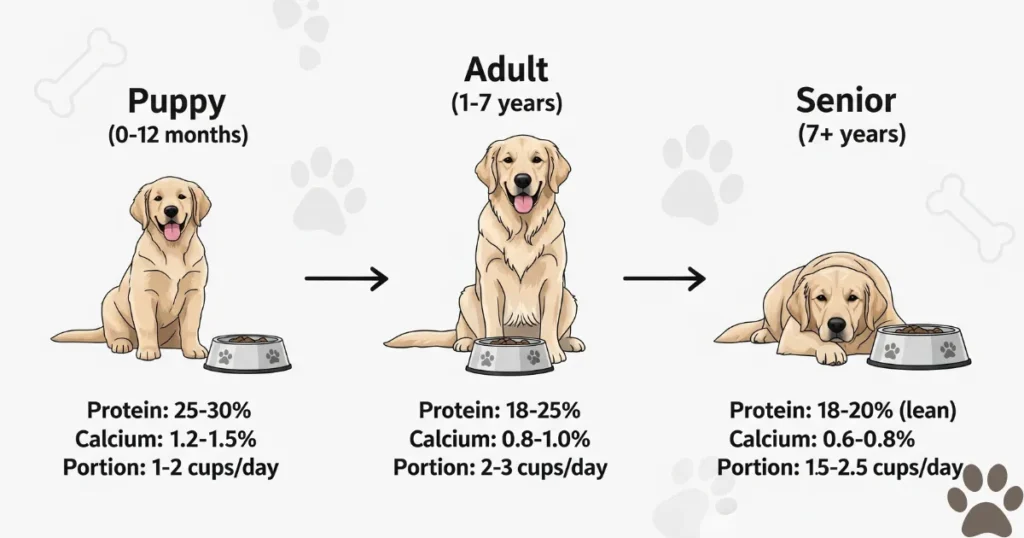
How to Choose the Best Dog Food for Large Breeds.
Based on my clinical experience, here’s my systematic approach to selecting large breed dog food:
1. Read the AAFCO Statement.
Every bag should have an AAFCO (Association of American Feed Control Officials) statement. For large breeds, look for:
- “Formulated to meet nutritional levels for growth of large breed puppies”.
- “Suitable for all life stages, including growth of large breed puppies”.
2. Analyze the Ingredient List.
I teach my clients to read ingredients like a detective:
First 5 Ingredients Should Include:
- Named meat source (chicken, beef, salmon).
- Whole grains or vegetables (brown rice, sweet potatoes).
- Named meat meals (if present).
Red Flags I’ve learned to avoid:
- Generic terms (” meat meal,” “poultry by-products”).
- Excessive grain fillers as primary ingredients.
- Artificial colors and flavors.
3. Verify Guaranteed Analysis.
The guaranteed analysis tells you the minimum and maximum nutrient levels. For the best dog food for large breeds, I look for:
- Crude Protein: 22-26% (puppies), 18-25% (adults).
- Crude Fat: 12-15% (puppies), 10-15% (adults).
- Calcium: 1.0-1.8% (crucial for large breeds).
- Phosphorus: 0.8-1.6%.
4. Consider Special Health Needs.
In my practice, I customise recommendations based on individual health concerns.
- For Hip Dysplasia Prevention: Foods with glucosamine (300-400mg/ cup) and chondroitin (200-300mg/ cup).
- For Allergies: Limited ingredient diets with novel proteins (venison, duck, fish).
- For Sensitive Stomachs: Easily digestible carbohydrates (rice, oats) and probiotics.
- For Weight Management: Higher protein (25-30%), lower fat (8-12%), added fiber.
Veterinarian’s Top Recommended Large Breed Dog Foods.
After years of seeing results in my patients, these are the brands I most frequently recommend:
Vet’s Pick: Premium Options.
1. Hill’s Science Diet Large Breed.
Why I recommend it: Clinically proven nutrition with optimal calcium levels.
Best for: Dogs with no specific health issues.
Pros: Veterinarian-formulated, consistent quality, widely available.
Cons: Higher price point, some dogs don’t love the taste.
2. Royal Canin Large Breed.
Why I recommend it: Breed-specific nutrition research.
Best for: Dogs needing targeted nutrition.
Pros: Extensive research backing, specific formulations.
Cons: Expensive, limited flavor options.
3. Eukanuba Large Breed.
Why I recommend it: High-quality protein sources, joint support.
Best for: Active large breed dogs.
Pros: Good protein quality, includes DHA.
Cons: Contains chicken by-products.
Owner’s Choice: Value Options.
1. Purina Pro Plan Large Breed.
Why owners love it: Good nutrition at a reasonable price.
Best for: Budget-conscious owners wanting quality.
Pros: Widely available, good ingredient quality, affordable.
Cons: Contains some fillers.
2. Diamond Naturals Large Breed.
Why owners choose it: Natural ingredients, probiotics included.
Best for: Owners preferring natural options.
Pros: Added probiotics, reasonable price, quality ingredients.
Cons: Less research than premium brands.
Grain-Free Options (When Medically Necessary).
I only recommend grain-free dog food for large breeds when there’s a diagnosed grain allergy, due to recent FDA investigations into potential links with heart disease.
1. Blue Buffalo Wilderness Large Breed.
Pros: High protein, no grains, real meat first ingredient.
Cons: Higher cost, potential DCM concerns.
2. Taste of the Wild High Prairie.
Pros: Novel proteins, probiotics, affordable grain-free option.
Cons: FDA investigation concerns, limited availability.
Feeding Guidelines and Schedule Recommendations.
Proper feeding isn’t just about choosing the right food– it’s about how much and when you feed. In my clinic, I see many large breed dogs with weight-related health issues that could be prevented with proper feeding practices.
Portion Control Guidelines.
I use this formula to calculate daily food requirements:
Puppies (2-4 meals per day):
- 8-12 weeks: 1-1.5 cups per 10 pounds of body weight.
- 3-6 months: 0.75-1 cup per 10 pounds of body weight.
- 6-12 months: 0.5-0.75 cups per 10 pounds of body weight.
Adults (1-2 meals per day):
- Active dogs: 20-25 calories per pound of body weight.
- Sedentary dogs: 15-20 calories per pound of body weight.
- Senior dogs: 15-18 calories per pound of body weight.
Sample Feeding Schedule.
Based on my recommendations to Golden Retriever owners:
- 8-16 Weeks: 4 meals daily (6 AM, 12 PM, 5 PM, 8 PM)
- 4-6 Months: 3 meals daily (7 AM, 1 PM, 6 PM)
- 6+ Months: 2 meals daily (7 AM, 6 PM).
I always recommend measuring food with a standard measuring cup and adjusting portions based on body condition, not just weight.
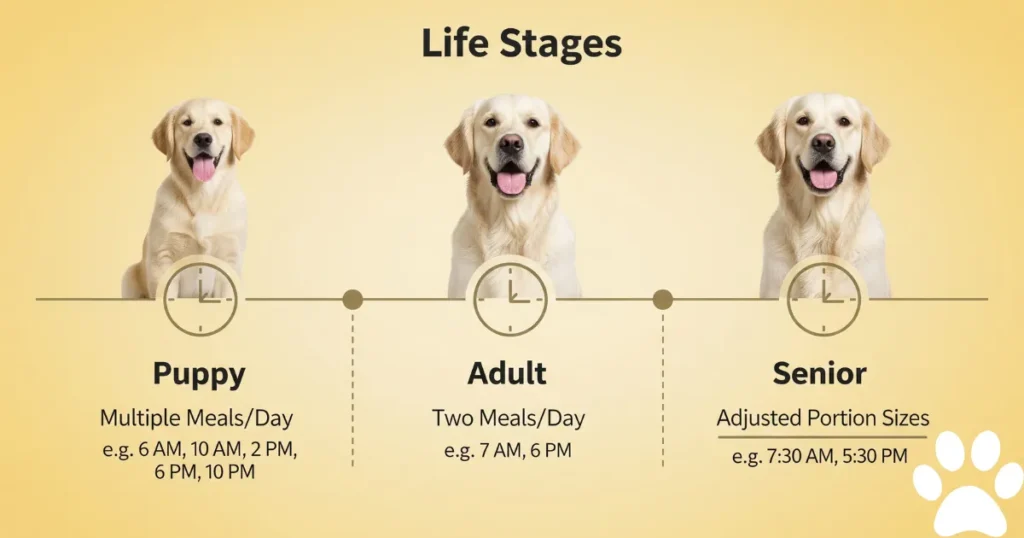
Common Feeding Mistakes I See in Practice.
Through thousands of consultations, these are the most frequent errors I encounter:.
Mistake # 1: Free Feeding.
The Problem: Leaving food out all day leads to overeating and prevents portion control.
My Solution: Scheduled meal times with measured portions.
Real Case: A Golden Retriever gained 15 pounds in 6 months due to free feeding. After implementing scheduled meals, he lost the excess weight in 4 months.
Mistake # 2: Ignoring Body Condition.
The Problem: Owners focus on weight instead of body condition score.
My Solution: I teach owners to feel for ribs and observe the waist tuck.
Clinical Note: A dog can be the “right weight” but still carry excess fat.
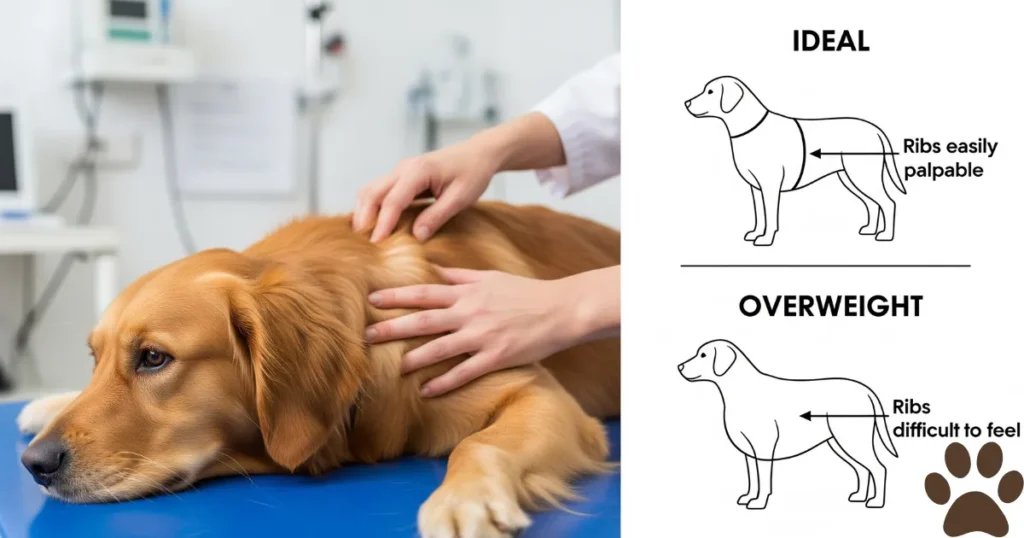
Mistake # 3: Too Many Treats.
The Problem: Treats can comprise 20-30% of daily calories without owners realizing.
My Solution: Treats should never exceed 10% of daily calories.
Case Example: I calculated that a patient’s “few daily treats” were adding 400+ calories per day.
Mistake # 4: Abrupt Food Changes.
The Problem: Switching foods suddenly causes digestive upset.
My Solution: 7-10 day gradual transition, mixing old and new foods.
Mistake # 5: Ignoring Life Stage Changes.
The Problem: Feeding puppy food too long or adult food too early.
My Solution: Transition to adult food at 12-18 months, depending on growth rate.
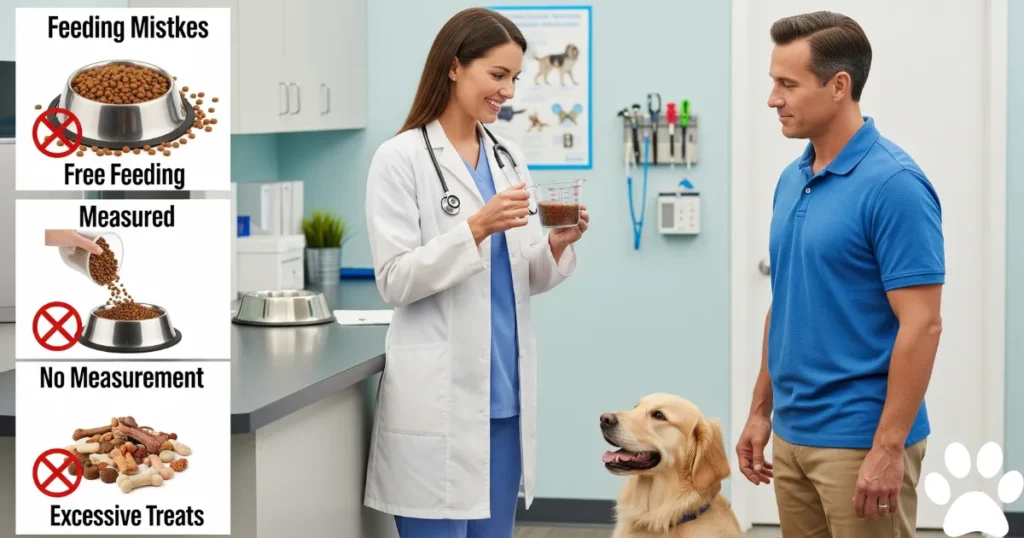
Special Dietary Considerations for Large Breeds.
Managing Food Allergies.
Food allergies affect approximately 10% of the dogs I see, with large breeds being particularly susceptible. Common allergens include:
- Protein sources: Chicken, beef, dairy.
- Grain sources: Wheat, corn, soy.
- Environmental factors: Often confused with food allergies.
My Diagnostic Approach:
- Elimination diet with novel protein (venison, duck, fish).
- Single carbohydrate source (sweet potato, rice).
- 8-12 week trial period.
- Gradual reintroduction to identify triggers.
Weight Management Strategies.
Obesity is epidemic in large breeds. In my practice, 60% of adult Golden Retrievers are overweight. Here’s my systematic approach:
Assessment Phase:
- Body condition scoring (1-9 scale, target is 4-5).
- Calculate ideal weight.
- Determine daily caloric needs.
Weight Loss Protocol:
- Reduce current calories by 20-25%.
- Increase protein to 25-30% to preserve muscle.
- Add fiber to promote satiety.
- Implement regular weigh-ins.
Case Study: “Max,” a 4-year-old Golden Retriever, came to me weighing 95 pounds (ideal: 70 pounds). Using a prescription weight management large breed dog food and portion control, he reached his target weight in 8 months and has maintained it for 2 years.
Senior Nutrition Adjustments.
As large breed dogs age, I modify their nutrition to address common age-related changes:
Cognitive Support: Foods with antioxidants (vitamin E, C) and omega-3 fatty acids
Joint Health: Higher levels of glucosamine (500mg+) and chondroitin (400mg+)
Kidney Support: Moderate phosphorus levels, high-quality proteins
Digestive Health: Probiotics and easily digestible ingredients.
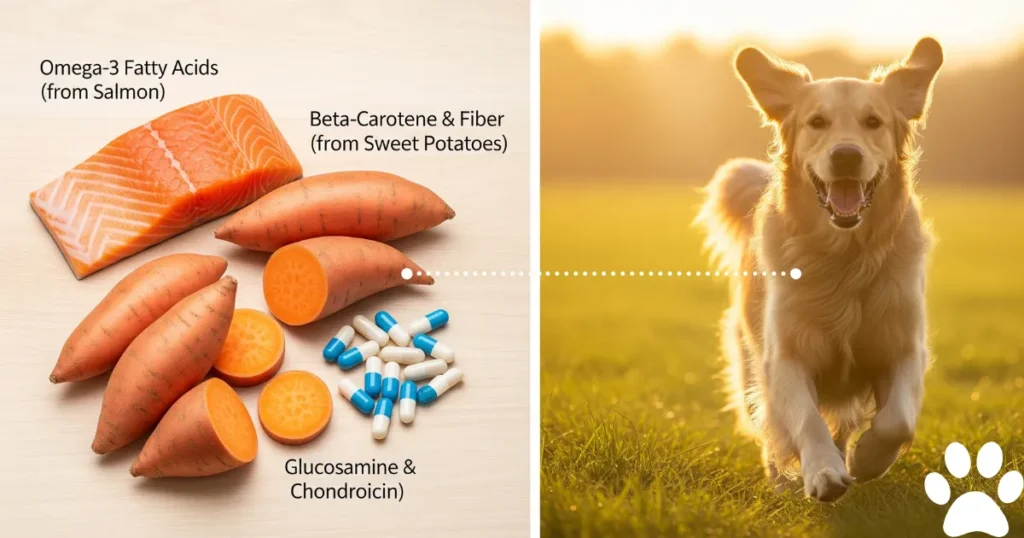
Understanding Dog Food Labels and Marketing Claims.
I spend considerable time educating owners about marketing versus nutrition facts. Here’s what really matters:
Meaningful Label Terms.
” Complete and Balanced”: Must meet AAFCO nutritional standards
“Natural”: Ingredients are not chemically synthesized
“Holistic”: No regulatory meaning– marketing term only “Premium”: No regulatory standards– marketing term.
Red Flag Marketing Terms.
” Human Grade”: No legal definition in pet food
“Vet Recommended”: May mean one veterinarian somewhere endorsed it
“Scientifically Proven”: Ask to see the actual studies
“Ancient Grains”: Marketing trend without proven benefits.
Reading Guaranteed Analysis Correctly.
The guaranteed analysis shows minimum and maximum values, not exact amounts:
- Crude Protein (minimum): Actual amount may be higher.
- Crude Fat (minimum): Actual amount may be higher.
- Crude Fiber (maximum): Actual amount may be lower.
- Moisture (maximum): Important for comparing wet vs. dry foods.
Cost-Effective Feeding Strategies.
Quality nutrition doesn’t have to break the bank. Here are my cost-saving strategies I share with clients:
Budget-Friendly Approaches.
Buy in Bulk: Purchase larger bags for better per-pound pricing Subscribe and Save: Many retailers offer 10-15% discounts for auto-delivery Generic Brands: Some store brands meet AAFCO standards at lower costs Preventive Nutrition: Investing in quality food prevents expensive health problems.
Cost Comparison Method.
I teach owners to compare foods by cost per day, not bag price:
Calculation: (Bag Price ÷ Cups per Bag) × Daily Cups = Daily Cost.
Example:
- Premium food: $60/30-cup bag, feed 3 cups daily = $6.00/ day.
- Budget food: $35/40-cup bag, feed 4 cups daily = $3.50/ day.
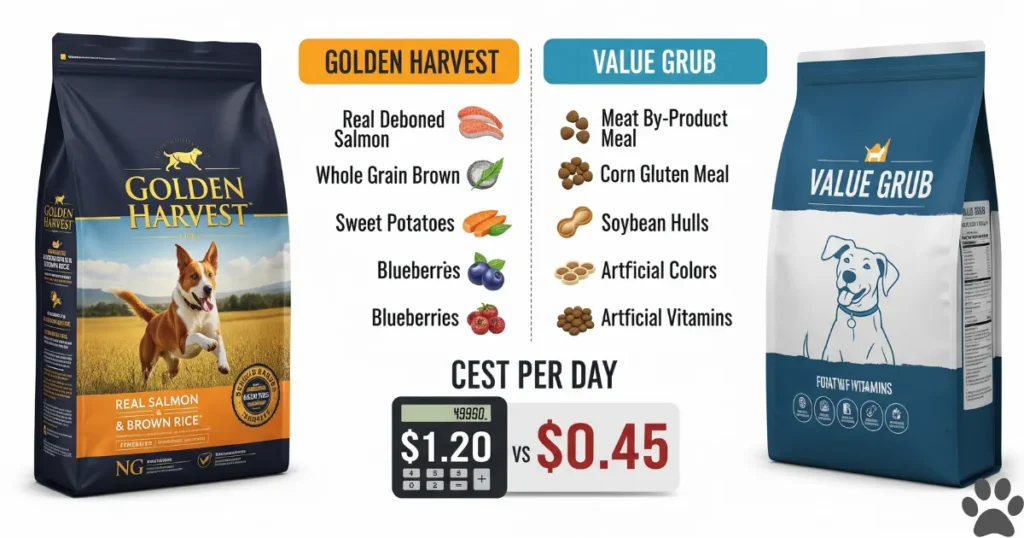
When to Invest More.
I recommend higher-cost foods for:
- Dogs with health issues requiring specialized nutrition.
- Puppies during critical growth periods.
- Senior dogs with multiple health concerns.
- Dogs with food allergies requiring limited ingredients.
Transitioning to New Large Breed Dog Food.
Proper food transitions prevent digestive upset. Here’s my proven protocol:
7-Day Transition Schedule.
- Days 1-2: 75% old food + 25% new food
- Days 3-4: 50% old food + 50% new food.
- Days 5-6: 25% old food + 75% new food
- Day 7+: 100% new food.
Monitoring During Transition.
I advise owners to watch for:
- Normal: Slight changes in stool consistency.
- Concerning: Vomiting, severe diarrhea, loss of appetite.
- Emergency: Blood in stool, signs of pain.
Slow Transition for Sensitive Dogs.
Some dogs need 2-3 week transitions. I extend the timeline for:
- Dogs with sensitive stomachs.
- Senior dogs with established eating patterns.
- Dogs recovering from illness.
- Previous bad reactions to food changes.
Creating a Lifetime Nutrition Plan.
Successful large breed nutrition requires adapting to your dog’s changing needs throughout their life. Here’s how I help my clients plan:
Puppy Stage (8 weeks – 18 months).
Focus: Controlled growth, proper calcium/phosphorus ratios.
Monitoring: Monthly weight checks, body condition scoring.
Food type: AAFCO-approved large breed puppy formula.
Feeding frequency: 3-4 meals daily.
Adult Stage (18 months – 7 years).
Focus: Maintaining ideal body weight, joint health support.
Monitoring: Semi-annual wellness exams, annual bloodwork.
Food type: Large breed adult maintenance formula.
Feeding frequency: 2 meals daily.
Senior Stage (7+ years).
Focus: Supporting aging organs, maintaining muscle mass.
Monitoring: Bi-annual exams, bloodwork, joint assessments.
Food type: Senior large breed or therapeutic diets as needed.
Feeding frequency: 2-3 smaller meals daily.
Should I feed grain-free dog food to my large breed dog?
Based on current veterinary research and my clinical experience, I only recommend grain-free diets when there’s a diagnosed grain allergy. The FDA investigation into potential links between grain-free diets and heart disease (dilated cardiomyopathy) in dogs has made me more cautious. Most dogs digest grains well, and grains provide valuable nutrients and fiber.
How much should I feed my Golden Retriever puppy?
Golden Retriever puppies need careful portion control to prevent rapid growth that can cause orthopedic problems. I recommend feeding 1-1.5 cups per 10 pounds of body weight daily, divided into 3-4 meals. Always follow your specific food’s feeding guidelines and adjust based on body condition, not just weight.
What’s the difference between large breed and regular dog food?
Large breed dog food contains controlled calcium and phosphorus levels (1.0-1.8% calcium, 0.8-1.6% phosphorus) to support proper bone development. Regular dog food often contains higher calcium levels that can cause developmental orthopedic diseases in large breed puppies. Adult large breed formulas also typically include joint support ingredients like glucosamine and chondroitin.
When should I switch my large breed puppy to adult food?
I recommend transitioning to adult dog food for large breeds between 12-18 months, depending on the individual dog’s growth rate. Golden Retrievers typically transition around 15-18 months. The key is waiting until growth plates close, which your veterinarian can determine through examination and possibly X-rays.
Can I mix wet and dry food for my large breed dog?
Yes, combining wet and dry large breed dog food can provide benefits like increased palatability and hydration. Calculate the total calories from both foods to prevent overfeeding. A common ratio I recommend is 75% dry food with 25% wet food, but adjust based on your dog’s preferences and nutritional needs.
How do I know if my large breed dog is overweight?
I teach owners the hands-on body condition assessment: you should easily feel (but not see) your dog’s ribs with gentle pressure, observe a visible waist when looking from above, and see an abdominal tuck when viewing from the side. If you can’t feel ribs easily or there’s no visible waist, your dog may be overweight.
Are expensive dog foods really better?
Price doesn’t always indicate quality, but there’s often a correlation. Premium best dog food for large breeds typically contains higher-quality protein sources, better digestibility, and more research backing their formulations. However, some mid-range foods meet all nutritional requirements effectively. I focus on ingredients, AAFCO compliance, and company reputation rather than price alone.
Should I give my large breed dog supplements?
If you’re feeding a complete and balanced large breed dog food, additional supplements are usually unnecessary and can sometimes be harmful. However, I may recommend specific supplements for individual health conditions like joint problems or skin issues. Always consult with your veterinarian before adding supplements to avoid nutrient imbalances.
Final Thoughts: Your Path to Optimal Large Breed Nutrition.
After 5 years of practice and thousands of consultations with large breed dog owners, I can confidently say that proper nutrition is one of the most powerful tools we have for ensuring our dogs live long, healthy lives. The best dog food for large breeds isn’t necessarily the most expensive or the most heavily marketed– it’s the one that meets your individual dog’s nutritional needs at their current life stage while supporting their long-term health.
Remember these key principles:
Life stage matters: Puppy, adult, and senior dogs have different nutritional requirements.
Portion control is crucial: Even the best food can cause problems if overfed.
Individual needs vary: What works for one dog may not work for another.
Quality ingredients matter: Look for named meat sources and avoid excessive fillers.
Veterinary guidance is valuable: Regular check-ups help catch problems early.
Whether you choose a premium brand or a budget-friendly option, the most important factor is consistency in providing balanced nutrition appropriate for your dog’s age, size, and health status. I encourage all large breed dog owners to work with their veterinarian to develop a nutrition plan tailored to their specific dog’s needs.
Your Golden Retriever, Lab, or German Shepherd depends on you to make informed decisions about their nutrition. By following the guidelines in this comprehensive guide, you’re taking an important step toward giving your large breed companion the best possible chance at a long, healthy, and happy life.
For more specific guidance on puppy nutrition, dry food comparisons, budget-friendly options, and brand recommendations, explore the supporting articles in this series. Each provides deeper insights into specialized aspects of large breed dog nutrition based on my clinical experience and the latest veterinary research.
Dr. Nabeel A.
Hi, I’m Dr. Nabeel Akram – a farm management professional by trade and a passionate Golden Retriever enthusiast at heart. With years of experience in animal science and livestock care, I’ve built a career around understanding animals—how they live, thrive, and bring value to our lives. This blog is a personal project born from that same passion, focusing on one of the most loyal and lovable breeds out there: the Golden Retriever. Whether I’m managing farm operations or sharing insights on canine health, behavior, and care, it all ties back to one core belief—animals deserve thoughtful, informed, and compassionate attention. Welcome to a space where professional expertise meets genuine love for dogs.
Facebook |
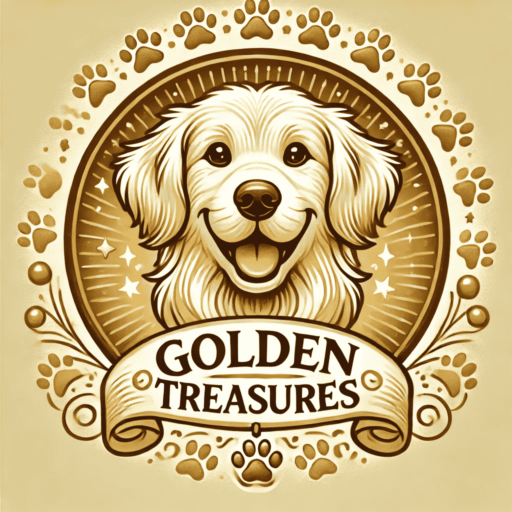
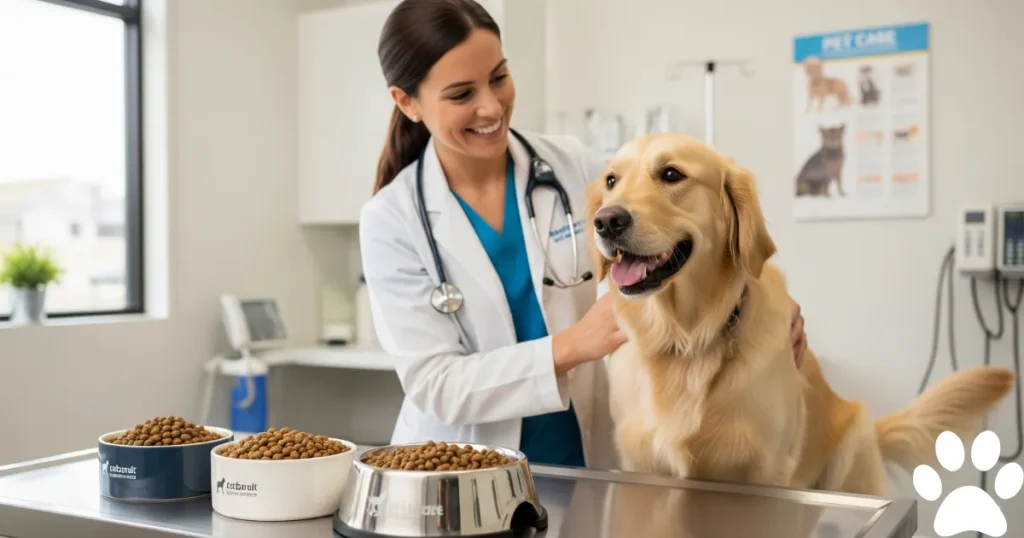
Links will be automatically removed from comments.